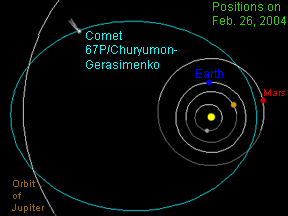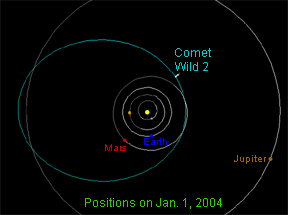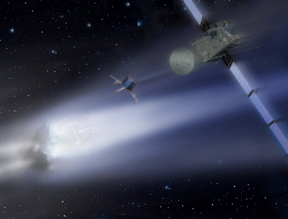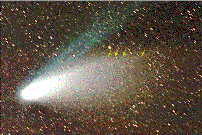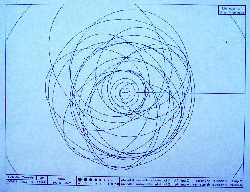Comets
| year found |
closest distance from Sun |
time to orbit Sun |
next or most recent pass by Sun |
inclination |
orbital eccentricity | ||
|---|---|---|---|---|---|---|---|
| Arend-Roland | 1956 | 0.316 | ? | ? | 119.95 | 1.000 | |
| Bennett | 1970 | 0.538 | ? | ? | 90.04 | 0.996 | |
| Biela | 1772 | 0.861 | 6.62 | ? | 12.55 | 0.756 | |
| Borrelly | 1904 | 1.358 | 6.68 | 2001 | 30.3 | .624 | |
| Brorsen-Metcalf | 1847 | 0.479 | 70.6 | 2060 | 19.33 | 0.972 | |
| Chiron | 1977 | ? | 51 | 2047 | ? | ? | |
| Churyumov-Gerasimenko | 1969 | 1.29 | 6.57 | 2009 | 7.12 | 0.632 | |
| d'Arrest | 1851 | 1.291 | 6.38 | 2001 | 19.43 | 0.625 | |
| Donati | 1858 | 0.578 | ? | ? | 116.96 | 0.996 | |
| Encke | 1786 | 0.341 | 3.31 | 2003 | 11.93 | 0.846 | |
| Giacobini-Zinner | 1900 | 1.028 | 6.59 | 1999 | 31.88 | 0.708 | |
| Grigg-Skjellerup | 1808 1902 (rediscovered) |
.989 | 5.09 | ? | 21.1 | 0.644 | |
| Hale-Bopp | 1995 | 0.9143 | 4000 | 1997 | ? | ? | |
| Halley | ? | 0.587 | 76.09 | 2062 | 162.24 | 0.967 | |
| Hyakutake | 1996 | 0.23 | ~30,000 | ~31,500 | ? | ? | |
| Ikeya-Seki | 1965 | 0.008 | 880 | 2845 | 141.86 | 1.000 | |
| IRAS-Araki- Alcock |
1983 | 0.991 | ? | ? | 73.25 | 0.990 | |
| Kohoutek | 1973 | 0.142 | ? | ? | 14.31 | 1.000 | |
| Lexell | 1770 | 0.674 | 5.60 | ? | 1.56 | 0.786 | |
| Linear | 1999 | 0.762 | ? | ? | 149 | .999 | |
| Morehouse | 1908 | 0.945 | ? | ? | 140.18 | 1.001 | |
| Mrkos | 1957 | 0.355 | ? | ? | 93.94 | 0.999 | |
| Schwassmann- Wachmann 1 |
1908 | 5.448 | 15 | 2004 | 9.75 | 0.105 | |
| Schwassmann- Wachmann 3 |
1930 | .937 | 5.36 | 2006 | 11.4 | .694 | |
| Shoemaker-Levy 9 | 1993 | collided with Jupiter in 1994 | |||||
| Swift-Tuttle | 1862 | 0.963 | 120 | ? | 113.56 | 0.960 | |
| Tempel 1 | 1867 | 1.5 | 5.51 | 2005 | 10.5 | 0.519 | |
| Tempel 2 | 1873 | 1.381 | 5.29 | ? | 12.44 | 0.545 | |
| West | 1976 | 0.197 | ? | ? | 43.07 | 1.000 | |
| Wild 2 | 1978 | 1.583 | 6.39 | 2003 | 3.2 | 0.540 | |
| Wirtanen | 1948 | 1.063 | 5.46 | 2013 | 11.7 | 0.652 | |
Last modified January 9, 2004 by Randy Russell.






